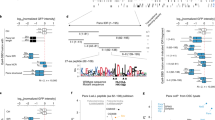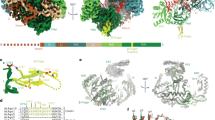Abstract
Argonaute (Ago) proteins mediate silencing of nucleic acid targets by small RNAs. In fission yeast, Ago1, Tas3 and Chp1 assemble into a RITS complex, which silences transcription near centromeres. Here we describe a repetitive motif within Tas3, termed the 'Argonaute hook', that is conserved from yeast to humans and binds Ago proteins through their PIWI domains in vitro and in vivo. Site-directed mutation of key residues in the motif disrupts Ago binding and heterochromatic silencing in vivo. Unexpectedly, a PIWI domain pocket that binds the 5′ end of the short interfering RNA guide strand is required for direct binding of the Ago hook. Moreover, wild-type but not mutant Ago hook peptides derepress microRNA-mediated translational silencing of a target messenger RNA. Proteins containing the conserved Ago hook may thus be important regulatory components of effector complexes in RNA interference.
This is a preview of subscription content, access via your institution
Access options
Subscribe to this journal
Receive 12 print issues and online access
$189.00 per year
only $15.75 per issue
Buy this article
- Purchase on Springer Link
- Instant access to full article PDF
Prices may be subject to local taxes which are calculated during checkout





Similar content being viewed by others
References
Motamedi, M.R. et al. Two RNAi complexes, RITS and RDRC, physically interact and localize to noncoding centromeric RNAs. Cell 119, 789–802 (2004).
Noma, K. et al. RITS acts in cis to promote RNA interference-mediated transcriptional and post-transcriptional silencing. Nat. Genet. 36, 1174–1180 (2004).
Sugiyama, T., Cam, H., Verdel, A., Moazed, D. & Grewal, S.I. RNA-dependent RNA polymerase is an essential component of a self-enforcing loop coupling heterochromatin assembly to siRNA production. Proc. Natl. Acad. Sci. USA 102, 152–157 (2005).
Verdel, A. et al. RNAi-mediated targeting of heterochromatin by the RITS complex. Science 303, 672–676 (2004).
Buhler, M., Verdel, A. & Moazed, D. Tethering RITS to a nascent transcript initiates RNAi- and heterochromatin-dependent gene silencing. Cell 125, 873–886 (2006).
Kim, D.H., Villeneuve, L.M., Morris, K.V. & Rossi, J.J. Argonaute-1 directs siRNA-mediated transcriptional gene silencing in human cells. Nat. Struct. Mol. Biol. 13, 793–797 (2006).
Ting, A.H., Schuebel, K.E., Herman, J.G. & Baylin, S.B. Short double-stranded RNA induces transcriptional gene silencing in human cancer cells in the absence of DNA methylation. Nat. Genet. 37, 906–910 (2005).
Janowski, B.A. et al. Involvement of AGO1 and AGO2 in mammalian transcriptional silencing. Nat. Struct. Mol. Biol. 13, 787–792 (2006).
Herr, A.J., Jensen, M.B., Dalmay, T. & Baulcombe, D.C. RNA polymerase IV directs silencing of endogenous DNA. Science 308, 118–120 (2005).
Lippman, Z. & Martienssen, R. The role of RNA interference in heterochromatic silencing. Nature 431, 364–370 (2004).
Matzke, M.A. & Birchler, J.A. RNAi-mediated pathways in the nucleus. Nat. Rev. Genet. 6, 24–35 (2005).
Verdel, A. & Moazed, D. RNAi-directed assembly of heterochromatin in fission yeast. FEBS Lett. 579, 5872–5878 (2005).
Eulalio, A., Behm-Ansmant, I. & Izaurralde, E. P bodies: at the crossroads of post-transcriptional pathways. Nat. Rev. Mol. Cell Biol. 8, 9–22 (2007).
Bruno, I. & Wilkinson, M.F. P-bodies react to stress and nonsense. Cell 125, 1036–1038 (2006).
Marx, J. Molecular biology. P-bodies mark the spot for controlling protein production. Science 310, 764–765 (2005).
Sheth, U. & Parker, R. Decapping and decay of messenger RNA occur in cytoplasmic processing bodies. Science 300, 805–808 (2003).
Meister, G. et al. Identification of novel argonaute-associated proteins. Curr. Biol. 15, 2149–2155 (2005).
Behm-Ansmant, I. et al. mRNA degradation by miRNAs and GW182 requires both CCR4:NOT deadenylase and DCP1:DCP2 decapping complexes. Genes Dev. 20, 1885–1898 (2006).
Liu, J. et al. A role for the P-body component GW182 in microRNA function. Nat. Cell Biol. 7, 1261–1266 (2005).
Jakymiw, A. et al. Disruption of GW bodies impairs mammalian RNA interference. Nat. Cell Biol. 7, 1267–1274 (2005).
Ding, L., Spencer, A., Morita, K. & Han, M. The developmental timing regulator AIN-1 interacts with miRISCs and may target the argonaute protein ALG-1 to cytoplasmic P bodies in C. elegans. Mol. Cell 19, 437–447 (2005).
Lingel, A., Simon, B., Izaurralde, E. & Sattler, M. Nucleic acid 3′-end recognition by the Argonaute2 PAZ domain. Nat. Struct. Mol. Biol. 11, 576–577 (2004).
Lingel, A., Simon, B., Izaurralde, E. & Sattler, M. Structure and nucleic-acid binding of the Drosophila Argonaute 2 PAZ domain. Nature 426, 465–469 (2003).
Song, J.J. et al. The crystal structure of the Argonaute2 PAZ domain reveals an RNA binding motif in RNAi effector complexes. Nat. Struct. Biol. 10, 1026–1032 (2003).
Ma, J.B., Ye, K. & Patel, D.J. Structural basis for overhang-specific small interfering RNA recognition by the PAZ domain. Nature 429, 318–322 (2004).
Yan, K.S. et al. Structure and conserved RNA binding of the PAZ domain. Nature 426, 468–474 (2003).
Parker, J.S., Roe, S.M. & Barford, D. Structural insights into mRNA recognition from a PIWI domain-siRNA guide complex. Nature 434, 663–666 (2005).
Ma, J.B. et al. Structural basis for 5′-end-specific recognition of guide RNA by the A. fulgidus Piwi protein. Nature 434, 666–670 (2005).
Yuan, Y.R. et al. Crystal structure of A. aeolicus argonaute, a site-specific DNA-guided endoribonuclease, provides insights into RISC-mediated mRNA cleavage. Mol. Cell 19, 405–419 (2005).
Rivas, F.V. et al. Purified Argonaute2 and an siRNA form recombinant human RISC. Nat. Struct. Mol. Biol. 12, 340–349 (2005).
Liu, J. et al. Argonaute2 is the catalytic engine of mammalian RNAi. Science 305, 1437–1441 (2004).
Meister, G. et al. Human Argonaute2 mediates RNA cleavage targeted by miRNAs and siRNAs. Mol. Cell 15, 185–197 (2004).
Miyoshi, K., Tsukumo, H., Nagami, T., Siomi, H. & Siomi, M.C. Slicer function of Drosophila Argonautes and its involvement in RISC formation. Genes Dev. 19, 2837–2848 (2005).
Tolia, N.H. & Joshua-Tor, L. Slicer and the Argonautes. Nat. Chem. Biol. 3, 36–43 (2007).
Girard, A., Sachidanandam, R., Hannon, G.J. & Carmell, M.A. A germline-specific class of small RNAs binds mammalian Piwi proteins. Nature 442, 199–202 (2006).
Aravin, A. et al. A novel class of small RNAs bind to MILI protein in mouse testes. Nature 442, 203–207 (2006).
Grivna, S.T., Beyret, E., Wang, Z. & Lin, H. A novel class of small RNAs in mouse spermatogenic cells. Genes Dev. 20, 1709–1714 (2006).
Okamura, K., Ishizuka, A., Siomi, H. & Siomi, M.C. Distinct roles for Argonaute proteins in small RNA-directed RNA cleavage pathways. Genes Dev. 18, 1655–1666 (2004).
Rand, T.A., Ginalski, K., Grishin, N.V. & Wang, X. Biochemical identification of Argonaute 2 as the sole protein required for RNA-induced silencing complex activity. Proc. Natl. Acad. Sci. USA 101, 14385–14389 (2004).
Rehwinkel, J., Behm-Ansmant, I., Gatfield, D. & Izaurralde, E. A crucial role for GW182 and the DCP1:DCP2 decapping complex in miRNA-mediated gene silencing. RNA 11, 1640–1647 (2005).
Eystathioy, T. et al. A phosphorylated cytoplasmic autoantigen, GW182, associates with a unique population of human mRNAs within novel cytoplasmic speckles. Mol. Biol. Cell 13, 1338–1351 (2002).
Petrie, V.J., Wuitschick, J.D., Givens, C.D., Kosinski, A.M. & Partridge, J.F. RNA interference (RNAi)-dependent and RNAi-independent association of the Chp1 chromodomain protein with distinct heterochromatic loci in fission yeast. Mol. Cell. Biol. 25, 2331–2346 (2005).
Carmichael, J.B. et al. RNA interference effector proteins localize to mobile cytoplasmic puncta in Schizosaccharomyces pombe. Traffic 7, 1032–1044 (2006).
Sen, G.L. & Blau, H.M. Argonaute 2/RISC resides in sites of mammalian mRNA decay known as cytoplasmic bodies. Nat. Cell Biol. 7, 633–636 (2005).
Liu, J., Valencia-Sanchez, M.A., Hannon, G.J. & Parker, R. MicroRNA-dependent localization of targeted mRNAs to mammalian P-bodies. Nat. Cell Biol. 7, 719–723 (2005).
Parker, J.S., Roe, S.M. & Barford, D. Crystal structure of a PIWI protein suggests mechanisms for siRNA recognition and slicer activity. EMBO J. 23, 4727–4737 (2004).
Song, J.J., Smith, S.K., Hannon, G.J. & Joshua-Tor, L. Crystal structure of Argonaute and its implications for RISC slicer activity. Science 305, 1434–1437 (2004).
Ehrenberg, M. & Tenson, T. A new beginning of the end of translation. Nat. Struct. Biol. 9, 85–87 (2002).
Nakamura, Y. & Ito, K. Making sense of mimic in translation termination. Trends Biochem. Sci. 28, 99–105 (2003).
Lewis, B.P., Shih, I.H., Jones-Rhoades, M.W., Bartel, D.P. & Burge, C.B. Prediction of mammalian microRNA targets. Cell 115, 787–798 (2003).
Stark, A., Brennecke, J., Russell, R.B. & Cohen, S.M. Identification of Drosophila MicroRNA targets. PLoS Biol. 1, E60 (2003).
Doench, J.G. & Sharp, P.A. Specificity of microRNA target selection in translational repression. Genes Dev. 18, 504–511 (2004).
Lewis, B.P., Burge, C.B. & Bartel, D.P. Conserved seed pairing, often flanked by adenosines, indicates that thousands of human genes are microRNA targets. Cell 120, 15–20 (2005).
Thermann, R. & Hentze, M.W. Drosophila miR2 induces pseudo-polysomes and inhibits translation initiation. Nature 447, 875–878 (2007).
Partridge, J.F. et al. Functional separation of the requirements for establishment and maintenance of centromeric heterochromatin. Mol. Cell 26, 593–602 (2007).
Golemis, E.A., Serebriiskii, I. & Law, S.F. The yeast two-hybrid system: criteria for detecting physiologically significant protein-protein interactions. Curr. Issues Mol. Biol. 1, 31–45 (1999).
Kustatscher, G., Hothorn, M., Pugieux, C., Scheffzek, K. & Ladurner, A.G. Splicing regulates NAD metabolite binding to histone macroH2A. Nat. Struct. Mol. Biol. 12, 624–625 (2005).
Moreno, S., Klar, A. & Nurse, P. Molecular genetic analysis of fission yeast Schizosaccharomyces pombe. Methods Enzymol. 194, 795–823 (1991).
Kelly, T.J. et al. The fission yeast cdc18+ gene product couples S phase to START and mitosis. Cell 74, 371–382 (1993).
Acknowledgements
We thank N. Daigle and J. Ellenberg for advice on imaging; D. Brunner (EMBL) and R. Allshire (Wellcome Trust Centre for Cell Biology) for help with S. pombe and strains; R. Pillai (EMBL) and W. Filipowicz (Friedich Miescher Institute) for Hiwi plasmid, advice and discussion; T. Gibson for linear-motif discussions; S. Narumiya (Kyoto University) for HeLa Kyoto cells; J. Parker and D. Barford for the A. fulgidus PIWI purification protocol; and members of A.G.L.'s laboratory, as well as A. Akhtar, J. Ellenberg, D. Brunner, J. Müller, K. Rippe, I. Mattaj and C. Margulies, for discussion. This work was supported by the EMBL and by grants from the EU Sixth Framework Programme, Marie Curie Early-Stage Training in Advanced Life Science Research (E.L.), the Peter and Traudl Engelhorn Foundation (M.H.), the Deutsche Forschungsgemeinschaft (M.W.H.), the Marie Curie Research Training Network 'Chromatin Plasticity' (A.G.L.) and the Network of Excellence 'The Epigenome' (A.G.L.).
Author information
Authors and Affiliations
Contributions
S.T., E.L., R.T., M.B., D.E., C.H. and A.G.L. performed the experiments. S.T., E.L., R.T., M.B., M.H., D.E., M.W.H. and A.G.L. designed, analyzed and interpreted the experiments. S.T. and A.G.L. wrote the paper with input from all other authors.
Corresponding author
Supplementary information
Supplementary Text and Figures
Supplementary Figures 1–3, Supplementary Table 1 (PDF 25235 kb)
Rights and permissions
About this article
Cite this article
Till, S., Lejeune, E., Thermann, R. et al. A conserved motif in Argonaute-interacting proteins mediates functional interactions through the Argonaute PIWI domain. Nat Struct Mol Biol 14, 897–903 (2007). https://doi.org/10.1038/nsmb1302
Received:
Accepted:
Published:
Issue Date:
DOI: https://doi.org/10.1038/nsmb1302
This article is cited by
-
AGO2 silences mobile transposons in the nucleus of quiescent cells
Nature Structural & Molecular Biology (2023)
-
Prokaryotic Argonaute from Archaeoglobus fulgidus interacts with DNA as a homodimer
Scientific Reports (2021)
-
New insights into tomato microRNAs
Scientific Reports (2018)
-
Structural disorder in plant proteins: where plasticity meets sessility
Cellular and Molecular Life Sciences (2017)
-
Small-RNA loading licenses Argonaute for assembly into a transcriptional silencing complex
Nature Structural & Molecular Biology (2015)



